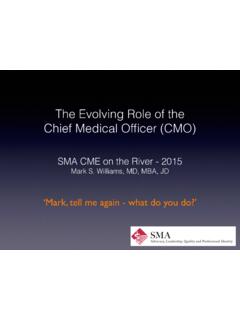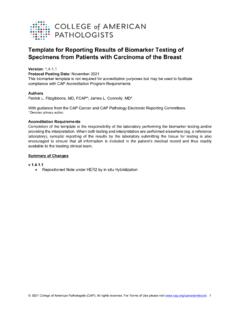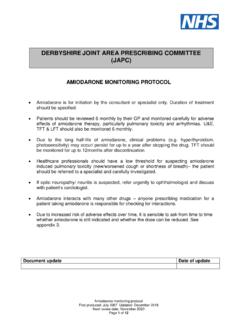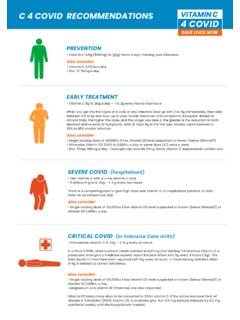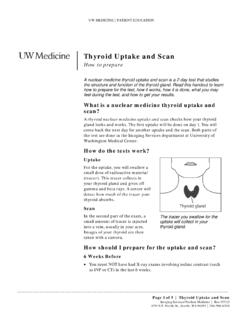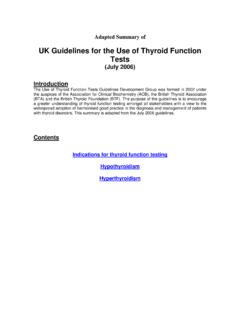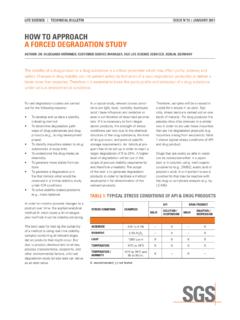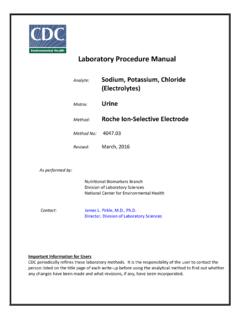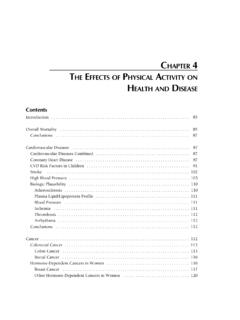Transcription of Care of the Adult Patient with Down Syndrome - SMA
1 Care of the Adult Patient with Down SyndromeWhitney Trotter Ross,MD,and Martin Olsen,MDAbstract:Individuals with Down Syndrome have an increased riskfor many conditions, including cardiovascular disease, cancer, infections,and osteoporosis, and endocrine, neurological, orthopedic, auditory, andophthalmic alsoare atincreased riskfor abuse and humanrights violations and receive fewer screenings and interventions than thepopulation without Down Syndrome . In this literature review, the mostcommon health conditions associated with Down Syndrome are exam-ined, along with the topics of sexual abuse, menstrual hygiene, contra-ception, and human rights. Clinical guidelines for this population aresummarized in an effort to assist practicing physicians in improving theirprovision of health care to the Adult Patient with Down Words: Adult , Down Syndrome , medical careDown Syndrome , also known as trisomy 21, occurs in 1 ofevery 691 live births in the United is by far themost common birth defect and chromosomal disorder in live-born its prevalence, there is minimal literatureon the comprehensive care of Adult patients with Down syn-drome.
2 Guidelines for the care of pediatric and adolescentpatients with Down Syndrome have been discussed more thor-oughly with Down Syndrome are at riskfor the same conditions as the population without Down syn-drome, in addition to the health problems associated with tri-somy most common causes of death in people withDown Syndrome include Alzheimer diseaseYrelated conditions,respiratory infections, leukemia, ischemic heart disease, cere-brovascular accidents, diabetes, and examine the most common health conditions asso-ciated with Down Syndrome , along with sexual abuse, men-strual hygiene, contraception, and human rights. We discussclinical guidelines for this population in an effort to assistpracticing physicians in improving their provision of healthcare to the Adult Patient with Down Syndrome (see also theonline-only table that summarizes the recommendations, ).Cardiovascular DiseaseBecause life expectancy has increased to almost 60 yearsin people with Down Syndrome ,12,13atherosclerotic cardio-vascular disease is a rapidly growing ,10 Patients withDown Syndrome are at increased risk for cardiovascular riskfactors, including diabetes mellitus, centripetal obesity, and ,14,15 They also have a less favorable lipid profile,with higher total cholesterol and triglycerides and lower high-density lipoprotein compared with their studiesshow increased mortality in the Down Syndrome population fromischemic heart disease, cardiovascular disease, and cerebrovas-cular ,10 Table 1 outlines suggested screening heart disease is the most frequent systemic mal-formation in children with Down Syndrome and is present in40% to 50% of the ,16,17 Adults with Down syn-drome who have congenital heart disease have higher all-causemortality rates10.
3 However, one study has shown that at an ex-perienced center, these patients could undergo cardiac surgerywith a low risk of morbidity and Points&Individuals with Down Syndrome have a continually length-ening life expectancy, leading to expanded healthcare needs inadult with Down Syndrome have a higher risk of manyconditions, including atherosclerosis, cardiovascular disease,endocrine disorders, some cancers, Alzheimer dementia,osteopenia, ophthalmic disorders, dysmenorrhea, and abuse;however, they do not, in general, receive the quality of careprovided to the population without Down health needs of adults with Down Syndrome should beviewed from the perspective of current standards of care andmanagement while making adjustments to match individualneeds and medical ArticleSouthern Medical Journal&Volume 107, Number 11, November 2014715 From the Department of Obstetrics and Gynecology, East Tennessee StateUniversity, Johnson requests to Dr Whitney Trotter Ross, East Tennessee State University,PO Box 70569 Johnson City, TN 37614.
4 E-mail: article has been developed as a Journal CME Activity by the SouthernMedical Association. Visit to view instructions,documentation, and the complete necessary steps to receive CME creditfor reading this article. Fees may apply. CME credit will be availablefor 2 years after date of digital content is available for this article. Direct URL citationsappear in the printed text, and links to the digital files are provided in theHTML text of this article on the journal s Web site ( ).The authors have no financial relationships to disclose and no conflicts ofinterest to July 9, *2014 by The Southern Medical Association0038-4348/0Y2000/107-715 DOI: 2014 The Southern Medical Association. Unauthorized reproduction of this article is DisordersThyroid DiseaseAlthough Down Syndrome is well known to be associatedwith thyroid dysfunction,14,19Y23more recent literature sug-gests that this association has been ,25 Much de-bate exists as to optimal screening frequency and benefit oftreating subclinical hypothyroidism.
5 Several studies showedthat transient hypothyroidism in this population is common,self-resolving, and not necessarily a precursor to definite ,25,26 Subclinical hypothyroidism is the mostcommon type of thyroid dysfunction, and there is no benefitto using thyroid replacement therapy to treat it22,24,27unlessthe Patient is symptomatic or has thyroid peroxidase ,28A screening interval of 5 years is recommended inasymptomatic ,28,29In patients with subclinical hypo-thyroidism, we recommend obtaining a thyroid antibody assay(thyroid microsomal and thyroid autoantibodies); if results arenormal, patients with subclinical hypothyroidism should con-tinue to be screened every 5 ,28If autoantibodies arepositive, then more frequent screening should be MellitusData on the prevalence of diabetes mellitus in patients individualswith Down Syndrome have a 3- to 10-fold increased risk of di-abetes mellitus and a 10-fold increase in mortality9,30,31;how-ever, other studies do not confirm ,32 Given the lack of dataon diabetes mellitus in adults with Down Syndrome , it is ap-propriate to test blood glucose and hemoglobin A1c in symp-tomaticpatientsandtofollowtheAmeric anDiabetesAssociationscreening recommendations (Table 2).
6 Early MenopauseConsensus exists that menopause occurs early in womenwith Down Syndrome , but clinical management has not ,34In 2001, the general population median age ofmenopause was years, whereas the median age for womenwith Down Syndrome ranged from to ,34,35 Inwomen ages 13 to 27, there is no difference between the per-centage with Down Syndrome who are ovulating (76%) andthat in the control group (73%).19 Menopausal symptoms mayTable screening for individuals with Down syndromePopulationInterventionCaveatsInd ividuals 2Y20 yFasting lipid panel every 3Y5ya(as long as resultsremain within normal limits)If any of following CVD risk factors are present: overweight(BMIQ85th percentile), obesity (BMIQ95th percentile),hypertension (BPQ95th percentile orQ140/90), cigarettesmoking, diabetes mellitus OR positive family historyof dyslipidemia or premature CVDAll individualsQ20 yFasting lipid panel every 5 ybNoneAll individualsQ18 yBP measurement every 1Y2ycScreen every year in people with BP 120Y139/80Y89,screen every 2 y in people with BPG120/80 BMI, body mass index; BP, blood pressure.
7 CVD, cardiovascular Academy of Pediatrics Preventive Services Task Force 2008 Preventive Services Task Force 2007 Diabetes Association screening recommendationsPopulation (age)InterventionCaveatsIndividuals 10Y21 y (or beginning atpuberty if occurs before age 10)Fasting plasmaglucose every 2 yIf any of following CVD risk factors are present: overweight (BMIQ85th percentile orweight9120% ideal for height) PLUS any 2 of the following risk factors: familyhistory of type 2 diabetes mellitus in first- or second-degree relative, nonwhiterace/ethnicity (Native American, African American, Latino, Asian American,Pacific Islander), signs or conditions associated with insulin resistance (acanthosisnigricans, hypertension, dyslipidemia, or PCOS)Individuals 21Y45 yConsider fastingplasma glucoseIf overweight (BMIQ25) and if additional risk factors are present: habitually physically inactive,first-degree relative with diabetes mellitus, member of high-risk ethnicity (same as for children),have delivered a baby weighing99 lb or have been diagnosed as having GDM, hypertensive(Q140/90), have dyslipidemia or PCOS, have signs associated with insulin resistance, history ofvascular diseaseAll individualsQ45 yFasting plasmaglucose every 3 yNoneBMI, body mass index; CVD, cardiovascular disease; GDM, gestational diabetes mellitus; PCOS, polycystic ovary fromDiabetes Care2013;36(Suppl 1) Ross and Olsen&Care of the Adult Patient with Down Syndrome716*2014 Southern Medical AssociationCopyright 2014 The Southern Medical Association.
8 Unauthorized reproduction of this article is difficult to identify in patientswith decreased verbal skills, butthey should be treated just as they are in people without Downsyndrome, with hormone therapy for hot flushes, irritability, andsleep disturbances. Hormone therapy should not be used inwomen with an increased risk of DisordersInvestigators have noted anatomic and physiologic differ-ences in the brains of individuals with Down Syndrome . Twoneurologic pathologies that occur with increased prevalence conditions increase in prevalence with advancing occur in a trimodal distribution: 40% occurring in thoseless than 1 year of age and 40% in those 20 to 30 years of third peak of seizure onset is believed to correlate with theonset of Alzheimer dementia later in life. The histopathologyconsistent with this dementia is present with near uniformity byage 35; however, prevalence studies indicate that not everyonedevelops the accompanying clinical ,41 Diagnos-ing Alzheimer dementia in patients with Down Syndrome can bechallenging because personality and behavioral changes presentas the first ,40,42 This differs from the general pop-ulation, in whom deficits of short-term memory, language, andorientation mental status examinations do not take into accountintellectual disability; Down syndromeYspecific screening ex-aminations are required.
9 The Dementia Scale for Down s Syn-drome, the Dementia Questionnaire for Persons with MentalRetardation, and the Cambridge Examination for Mental Dis-orders of Older People with Down s Syndrome and Others withIntellectual Disabilities have been tested in this ,44A baseline battery of dementia testing should be performed forall patients with Down Syndrome at least once before age 35,with repeat testing every 1 to 5 years ,44 CancersLeukemia occurs with high frequency in the Down syn-drome ,45 The most common types are acute lym-phocytic leukemia and myeloid leukemia of Down acute lymphocytic leukemia, the presentation and courseof disease are similar to that of the general population; however,with myeloid leukemia of Down Syndrome , the counterpartsof which are myeloid dysplastic Syndrome and acute myeloidleukemia, the course and response to treatment differ. Intensivetreatment leads to better survival rates than in patients withoutDown with Down Syndrome also have increased risks ofretinoblastoma, germ cell tumors (especially testicular carcinoma),and ,45 Conversely, solid tumors, most notably breastand lung cancers, and secondary malignancies are no screening examinations show improvedleukemia outcomes in the general population, because of the in-creased risk in Down Syndrome , signs and symptoms of leukemiaand lymphoma such as refractory anemia, lethargy, fever, painfuljoints and extremities, pallor, lymphadenopathy, hepatospleno-megaly, bleeding, or easy bruising should be evaluated with acomplete blood yearly testicular and ophthalmicexaminations may help in the detection of these cancers.
10 It isrecommended that women with intellectual disabilities followthe same mammography screening as that in the populationwithout intellectual disabilities,46but there is insufficient evi-dence to reach a definitive conclusion regarding women withDown DiseasesInfectious diseases account for one-fifth of all Down syn-drome illnesses account for the largest pro-portion of infections and are the leading cause of ,12,48 The increased susceptibility to respiratory infectionsis thought to be multifactorial and includes immune system de-ficiency,6,49anatomical defects of the respiratory tract, obstructivesleep apnea, gastroesophageal reflux, and chronic silent aspira-tion. Because of this high mortality, yearly influenza vaccinationsshould be encouraged and individuals with Down syndromeconsidered candidates for serial boosters of System DisordersOf the autoimmune digestive diseases, only celiac disease usually is diagnosed in childhood50; however, itcan present atany age and is mostcommonly silent is 5% in the Down Syndrome ,50 Thereare no screening guidelines for adults with Down Syndrome ,but because of the increased risk, chronic abdominal symptoms(including vague symptoms such as dyspepsia, diffuse abdomi-nal pain, and flatulence), mouth sores, and skin rashes shouldbe addressed and evaluated with serologic antibody testing; acombination of immunoglobulin A tissue transglutaminase andtotal immunoglobulin A is gut motility leading to chronic constipation isa common problem in people with Down Syndrome .

